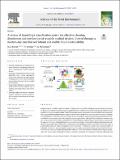| dc.contributor.author | Rowan, Neil J. | |
| dc.contributor.author | Kremer, Terra | |
| dc.contributor.author | McDonnell, Gerald | |
| dc.date.accessioned | 2023-04-05T14:38:49Z | |
| dc.date.available | 2023-04-05T14:38:49Z | |
| dc.date.copyright | 2023 | |
| dc.date.issued | 2023-03-22 | |
| dc.identifier.citation | Rowan, N.J., Kremer, T., McDonnell, G. (2023). A review of Spaulding's classification system for effective cleaning, disinfection and sterilization of reusable medical devices: viewed through a modern-day lens that will inform and enable future sustainability. Science of the Total Environment 878: 162976 | en_US |
| dc.identifier.uri | https://research.thea.ie/handle/20.500.12065/4463 | |
| dc.description.abstract | Despite advances in medicine and innovations in many underpinning fields including disease prevention and control,
the Spaulding classification system, originally proposed in 1957, remains widely used for defining the disinfection and
sterilization of contaminated re-usable medical devices and surgical instruments. Screening PubMed and Scopus databases
using a PRISMA guiding framework generated 272 relevant publications that were used in this review. Findings
revealed that there is a need to evolve how medical devices are designed, and processed by cleaning, disinfection (and/
or sterilization) to mitigate patient risks, including acquiring an infection. This Spaulding Classification remains in use
as it is logical, easily applied and understood by users (microbiologists, epidemiologists, manufacturers, industry) and
by regulators. However, substantial changes have occurred over the past 65 years that challenge interpretation and application
of this systemthat includes inter alia emergence of newpathogens (viruses, mycobacteria, protozoa, fungi), a
greater understanding of innate and adaptive microbial tolerance to disinfection, toxicity risks, increased number of
vulnerable patients and associated patient procedures, and greater complexity in design and use of medical devices.
Common cited examples include endoscopes that enable non- or minimal invasive procedures but are highly sophisticated
with various types of materials (polymers, electronic components etc), long narrow channels, right angle and heat-sensitive components and various accessories (e.g., values) that can be contaminated with high levels of microbial
bioburden and patient tissues after use. Contaminated flexible duodenoscopes have been a source of several significant
infection outbreaks, where at least 9 reported cases were caused by multidrug resistant organisms [MDROs] with no
obvious breach in processing detected. Despite this, there is evidence of the lack of attention to cleaning and maintenance
of these devices and associated equipment. Over the last few decades there is increasing genomic evidence of
innate and adaptive resistance to chemical disinfectant methods along with adaptive tolerance to environmental
stresses. To reduce these risks, it has been proposed to elevate classification of higher-risk flexible endoscopes (such
as duodenoscopes) from semi-critical [contact with mucous membrane and intact skin] to critical use [contact with
sterile tissue and blood] that entails a transition to using low-temperature sterilization modalities instead of routinely
using high-level disinfection; thus, increasing the margin of safety for endoscope processing. This timely review addresses
important issues surrounding use of the Spaulding classification system to meet modern-day needs. It specifically
addresses the need for automated, robust cleaning and drying methods combined with using real-time
monitoring of device processing. There is a need to understand entire end-to-end processing of devices instead of
adopting silo approaches that in the futurewill be informed by artificial intelligence and deep-learning/machine learning.
For example, combinational solutions that address the formation of complex biofilms that harbour pathogenic and
opportunistic microorganisms on the surfaces of processed devices. Emerging trends are addressed including future
sustainability for the medical devices sector that can be enabled via a new Quintuple Helix Hub approach that combines
academia, industry, healthcare, regulators, and society to unlock real world solutions. | en_US |
| dc.format | PDF | en_US |
| dc.language.iso | eng | en_US |
| dc.publisher | Elsevier | en_US |
| dc.relation.ispartof | Science of the Total Environment | en_US |
| dc.rights | Attribution-3.0 United States | * |
| dc.rights.uri | http://creativecommons.org/licenses/by/3.0/us/ | * |
| dc.subject | Medical devices, sustainability | en_US |
| dc.subject | Spauling classification, cleaning, processing | en_US |
| dc.subject | Patient risk, endoscopes, reprocessing | en_US |
| dc.title | A review of Spaulding's classification system for effective cleaning, disinfection and sterilization of reusable medical devices: viewed through a modern-day lens that will inform and enable future sustainability | en_US |
| dc.type | info:eu-repo/semantics/article | en_US |
| dc.contributor.affiliation | Technological University of the Shannon: Midlands Midwest | en_US |
| dc.description.peerreview | yes | en_US |
| dc.identifier.orcid | https://orcid.org/0000-0003-1228-3733 | en_US |
| dc.identifier.orcid | https://orcid.org/0000-0003-1228-3733 | en_US |
| dc.rights.accessrights | info:eu-repo/semantics/openAccess | en_US |
| dc.subject.department | Bioscience Research Institute TUS: Midlands | en_US |
| dc.type.version | info:eu-repo/semantics/publishedVersion | en_US |


